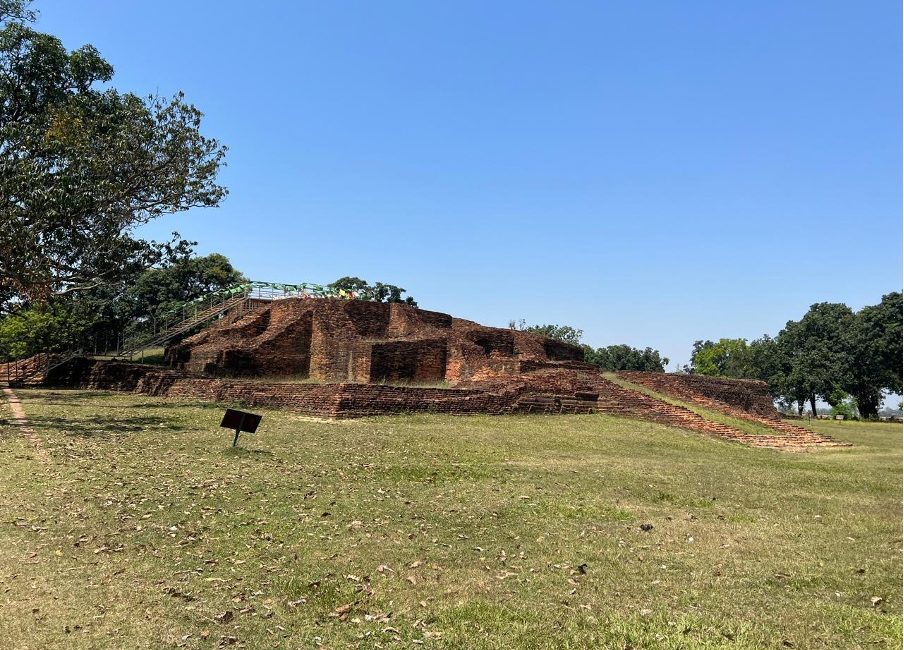Kudan; ancient monastery remains near Gotihawa. Image by the author
By Anjana Timalsina
The name of Lumbini is famous. It is typically known as the pilgrimage spot where Mayadevi gave birth to Siddhartha Gautama. Meanwhile, the equally important Kapilvastu was the fabled capital of the Shakya clan, which was ruled by Siddhartha’s father, Suddhodhana. Many historians and archaeologists agree that it here where Siddhartha first began his journey of spiritual awakening. When he left his wife and son, for the path of enlightenment, it was here. He later attained Nirvana in Bodh Gaya in India and spread his teachings across the Gangetic Plain.
The Pali texts of early Buddhism mention Seven Buddhas of Antiquity (Saptatathagata). They are Vipassi, Sikhi, Vessabhu, Kakusandha or Krakuchhanda, Konagamana or Kanakamuni, Kassapa or Kasyapa, and Gautama. The text also describes that the Buddhas Krakuchhanda, Kanakamuni, Kasyapa and Gautama are the Buddhas who belong to bhaddakappa or bhaddakalpa.
There has been significant research about the locations where Gautama Buddha might have tread, including his birthplace Lumbini, Kapilavastu, the the capital of his father’s kingdom; and Tilaurakot, which lies inside the territory of present Nepal. What is less well known is that two former Buddhas, Kakusandha or Krakuchhanda and Konagamana or Kanakamuni are recorded as having lived in the same location as Kapilavastu.
The Buddha Krakuchhanda was born in Kshema or Kshemavati to a Brahmin, Agnidatta. The Chinese travellers Faxian and Xuanzang mentioned that “to the south-east; almost 96 miles from Sravasti there is an old city where the stupa and stone pillar of Krakuchhanda Buddha can be found.” Centuries later, when the site was explored and excavated by Alexander Fuhrer and Dr. George Buhler from 1896 to 1897, they came across the relic of the ancient Buddha which was rare and extraordinary on its own. Moreover, Fuhrer added in his report that it may be difficult to identify exactly which period these holy remains began to be religiously venerated. The worship of the shrine and site was apparently fully developed before the time of Ashoka the Great.

The birth place of Kanakamuni or Konagamana Buddha is also known as Sobhavati in ancient Buddhist scriptures. Those texts describe how Buddha Kanakamuni was born in the house of the Brahmin Yajndatta. He was titled as Kanakamuni because during the time of his birth, a shower of gold fell from heaven. Again, Xuanzang describes in his diary that:
“To the north-east town of Krakuchhanda Buddha, going about 5 miles we come to an old capital in which there is stupa which was there to commemorate the birth of Kanakamuni Buddha. Again moving further to the north of the city there is a stupa containing the relics of his bequeathed body. In front of this, there is a stone pillar with a lion on the top which is almost 20 feet high and the pillar is connected with his Nirvana which was again built by Ashoka.”
The reason to emphasize Kapilvastu is because these two previous Buddhas walked the earth before Shakyamuni Buddha and were born in the same area. Presently, their birthplaces are known as Niglihawa and Gotihawa in the local tongue. The holy site of Nilglihawa is approximately 9 kilometers northeast from Tilaurakot whereas, Gotihawa is almost 8 kilometers southwest from Tilaurakot as well.
The stone inscription of Niglihawa has text inscribed in Brahmi saying;
DEVANAM PIYENA PIYADASINA lajina-chodasavasa [bhisi] tena
BUDHASA KONAKAMANASA thube-dutiyam vadhite
[Visativa] sabhisitena-cha atana-agacha-mahiyite
[Silathabe-cha usa] papite
According to the book The Buddha’s Natal Landscape as Interpreted by the Pioneers (2019) by Basanta Bidari, the translation of the text is “King Piyadasina, beloved of the gods, having been anointed fourteen years, increased for the second time the stupa of Buddha Konakamana; and having been anointed [twenty years], he came himself and worshipped; and caused this stone pillar to be erected”.
On the other hand, the stone pillar of the Gotihawa is broken from the top, but interestingly is in the very position as erected by Emperor Ashoka. There are still visible structures of stupa near the pillar but presently they remain buried.
The above mentioned information can be found in the diary of Faxian, who visited these sites of Nepal and India around 400 AD and 414 AD. Later, Xuanzang also visited most of the Buddhist sites in Nepal and India between 629 and 645, writing in detail about the condition of these places in his diary. The travel accounts of these Chinese travellers became a significant guide book to 20th century archaeologists and historians. Eventually they also helped in identifying these places as the birthplaces of previous Manushi Buddhas.
Both of these holy sites of previous Buddhas were described as areas that held the remains of ancient stupas, monastery and structures made with bricks structures in archaeological reports of early 20th century. However, the focus of research has remained focused on Shakyamuni Buddha in recent years, which somehow overshadows the significance of these sites. And I strongly believe Kapilvastu, including both Gotihawa and Niglihawa, should be remembered and visited as a place that included past Buddhas.
References
Lumbini Development Trust. 2019. The Buddha’s Natal Landscape as Interpreted by the Pioneers. Kathmandu: Government of Nepal; Ministry of Culture, Tourism and Civil Aviation. (www.lumbinidevtrust.gov.np)


